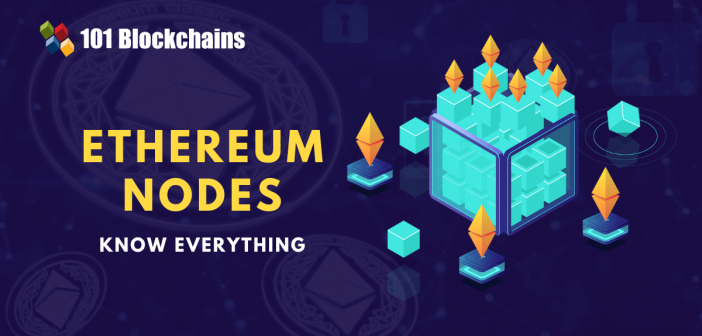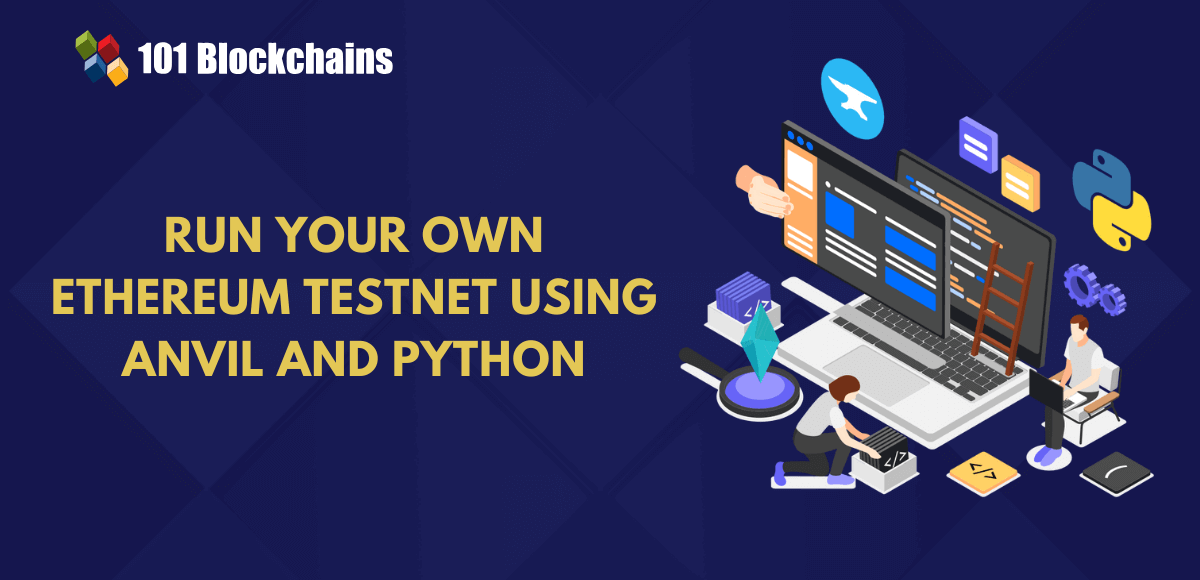Learn how blockchain truly works, master key definitions, and uncover what makes smart contracts so "smart." Dive into the fundamentals, gain valuable insights, and start your blockchain journey today!

- Ethereum
James Howell
- on November 07, 2022
What are Ethereum Nodes?
The concept of peer-to-peer transactions and networks has fuelled prominent advancements in the field of technology. As compared to the conventional assumptions about setbacks of distributed networks, blockchain technology has set new standards for resource usage and efficiency. Have you heard of Ethereum and Ethereum Nodes? The second biggest blockchain network has been serving exclusive opportunities for creating an ecosystem of decentralized applications.
Therefore, the interest in learning about Ethereum nodes explained in detail is essential for every individual who wants to learn about Ethereum. The following discussion offers you a comprehensive introduction to Ethereum nodes alongside their types. In addition, you can also learn more about the essential requirements for running an Ethereum node.
Excited to build your skill in Ethereum development by leveraging the ethers.js library? Enroll Now in Ethers.Js Blockchain Developer Course!
What Is an Ethereum Node?
The first highlight of an introduction to Ethereum nodes would emphasize their definition. You can identify the Ethereum blockchain as a distributed network of computers that run the software or client for verifying blocks and transaction data. The software application or client must be operational on a computer to qualify as an Ethereum node.
One of the basic answers to “what is an Ethereum node” suggests that it is one of the foundation blocks of the Ethereum blockchain. You can start learning about nodes once you have developed an in-depth understanding of peer-to-peer networks. The best way to start learning about Ethereum nodes is to choose training courses that could help you familiarize yourself with the fundamentals of Ethereum technology.
As of now, you need to understand that nodes are practically instances of Ethereum client software connected with other computers, which also run Ethereum and form a network. The explanation for Ethereum node requirements also calls for a detailed overview of the technical facets of Ethereum. The client serves as an Ethereum implementation, responsible for verifying data in accordance with protocol rules alongside ensuring network security.
Excited to learn the basic and advanced concepts of ethereum technology? Enroll Now in The Complete Ethereum Technology Course
Before and After the Merge
The Merge is one of the critical phenomena which might change how Ethereum works. Prior to the Merge, the execution and consensus layers served as isolated networks, with all the transactions and user activity happening on the Ethereum execution layer. A specific client software served the execution environment alongside consensus verification with the blocks created by miners. The consensus layer, referred to as the Beacon Chain, has been working individually since December 2020. Ethereum offered Proof of Stake consensus and worked on coordination of the validator network according to Ethereum data.
After the Merge, the description of an Ethereum nodes list might remain the same, albeit with subtle differences since December 2020. Now, Ethereum would switch to Proof of Stake by bridging the consensus layer and execution layer. The connection of these networks would offer the flexibility for execution and consensus for verifying the state of Ethereum. Ethereum would also offer a modular design according to encapsulated complexity with different pieces of software working with each other. As a result, the Merge could happen seamlessly alongside enabling the reuse of different clients, such as in layer 2 solutions.
Start learning about second-most-popular blockchain network, Ethereum with World’s first Ethereum Skill Path with quality resources tailored by industry experts Now!
What is Client Diversity?
Client diversity is another notable concept in the fundamentals of the Ethereum blockchain. You can find additional insights on ‘what is an Ethereum node‘ by reflecting on such concepts. The consensus clients and execution clients have their foundations in different programming languages with the contributions of different teams. Different client implementations could help strengthen the network by reducing the reliance on one codebase.
The basic goal of the Ethereum network emphasizes diversity without any client intervention, thereby removing the chances for a single point of failure. With the facility of variety in programming languages, Ethereum could have better chances of expanding the developer community. As a result, developers could have better chances of creating client integrations in their preferred programming language.
Want to develop in dept understanding of Ethereum development? Enroll Now in Ethereum Development Fundamentals Course
Types of Nodes
The next crucial highlight in a description for Ethereum nodes would refer to the Ethereum node types and their significance. As a matter of fact, you can run an Ethereum node only through an understanding of different types of nodes and how they consume data. The three common options among nodes that clients could run include a light node, a full node and an archive node. In addition, you should also notice the availability of alternatives for different sync strategies, which can allow faster synchronization time. Synchronization enables faster updates regarding the state of Ethereum in different instances. Here is an outline of the different types of Ethereum nodes.
-
Full Nodes
The first entry among the types of Ethereum nodes explained in detail would focus on the full node. A full node is capable of storing full blockchain data along with periodic pruning to ensure that it does not store all data going back to the genesis block. The full node would play a major role as a participant in block validation alongside carrying out verification for blocks and states. A full node delivers the flexibility for deriving all states, although old states could be subject to reconstruction from requests to archive nodes. Full nodes could serve the network and offer the required data according to requests.
Build your identity as a certified blockchain expert with 101 Blockchains’ Blockchain Certifications designed to provide enhanced career prospects.
-
Light Node
The second group of Ethereum nodes is the light nodes. Rather than downloading each block, the light nodes work by downloading block headers. The headers feature summary information regarding the content in the blocks, and any other information needed for the light node would be requested from a full node. A light node could independently carry out data verification received for state roots in block headers.
Light nodes could empower users to work in the Ethereum network without high bandwidth or powerful hardware needed for running full nodes. Furthermore, light nodes could also facilitate transactions on mobile phones alongside embedded devices. Light nodes do not work for consensus, albeit with access to Ethereum blockchain as a full node.
The Ethereum node requirements for a light node point at the execution client Geth, featuring a light sync option. On the other hand, a light Geth node would depend on full nodes offering light node data. At the same time, only certain full nodes could offer light node data, thereby implying that light nodes could fail to find peers. As of now, you cannot find production-ready light clients for use on the consensus layer.
On the other hand, many light nodes for the consensus layer are under development. In addition, light nodes have been discovering potential routes for offering light client data across the gossip network. Now, the gossip network can support a network of light nodes without the need for full nodes for serving requests. Ethereum does not feature a large Ethereum nodes list for light nodes, with light node support being expected in the future.
-
Archive Node
The overview of different types of archive nodes would also refer to archive nodes. An archive node could help in storing everything in a full node alongside developing the collection of historical states. It is an essential requirement for querying simple transactions and testing own transactions without the need for mining. Data in archive nodes would represent different units of terabytes, thereby making the archive nodes less appealing for average users. On the other hand, chain analytics, block explorers, and wallet vendors would find exceptional use of archive nodes.
The explanation for Ethereum node types also focuses on syncing clients in any mode. Syncing clients could result in the pruning of blockchain data for full and light nodes. As a result, you cannot access any archive of different historical states. On the other hand, the full node could develop the archive of historical states on demand.
Curious to learn about blockchain implementation and strategies? Enroll Now in Blockchain Technology – Implementation And Strategy Course!
Benefits of Running an Ethereum Node
The most obvious highlight in the discussion on Ethereum nodes would focus on the benefits. As a node operator, you can use Ethereum directly in a trustless and private manner alongside supporting decentralization and security in the Ethereum network. Here is an overview of the benefits for users and the network.
-
Advantages for Users
The foremost advantage of running your Ethereum node focuses on using Ethereum in a private, trustless and independent manner. Users don’t have to trust the network as they have sole privilege on verification of data on their own with the client. Some of the notable advantages of Ethereum node requirements for users would include the following.
- The node can verify blocks and transactions in accordance with consensus rules, thereby implying independence from other nodes.
- Your node enables you to use your Ethereum wallet and dApps with better privacy and security. As a result, you wouldn’t have to leak balances and addresses to random nodes.
- You could provide their own custom RPC endpoints. The publicly hosted Ethereum endpoint or private hosted Ethereum endpoints empower people to use your node alongside avoiding large centralized providers.
- Having your own node helps you directly stake ETH for securing the network and earning rewards.
- The assurance of your own node could help in running and self-hosting other services dependent on data from Ethereum. For example, the node can serve as a Beacon Chain Validator, layer 2 solutions, payment processors, block explorers, infrastructure, and others.
- Users could also rely on the benefits of connecting to their own node by using Inter-process Communications or IPC for rewriting the node. You could then use the node for loading the program as a plugin. As a result, it could provide the assurance of low latency, thereby helping in achieving more efficiency in processing data.
Excited to know about how to become an Ethereum developer? Check the quick presentation Now on: How To Become an Ethereum Developer?
-
Advantages for Networks
The advantages of Ethereum nodes explained in detail would also focus on benefits for the networks. With the help of a diverse set of nodes running unique client applications, the Ethereum network can ensure better health, operational resilience, and security. Here is an outline of some of the prominent value benefits of nodes for the Ethereum network.
- More nodes on the Ethereum network could offer a considerably diverse and robust network. More nodes on the Ethereum network could help in achieving the true objective of decentralization through a reliable and censorship-resistant system.
- In the event of security attacks leading to disabled crypto-economic safeguards with Proof of Stake, nodes could help in implementing social recovery. The full nodes could perform a social recovery by following the honest chain.
- Full nodes could work on enforcing consensus rules, thereby ensuring they cannot be tricked into accepting blocks that do not follow them. As a result, it can offer additional security with comprehensive verification to ensure that validators cannot attack the network.
- Another notable highlight in explaining what an Ethereum node for the network would focus on is allowing lightweight clients to access blockchain data. During peak usage time, the network needs an adequate number of full nodes for maintaining light nodes in sync. It is also important to remember that light nodes would never store the whole blockchain state data. On the contrary, they work by verifying data through the state roots stored in block headers. The light nodes could request additional information from the blocks according to their requirements.
Setting Up your Node
The distinct Ethereum node requirements for different stages of setting up the node could deliver a plausible impression of how the node works. As software, you can think of running a node as downloading a copy of the Ethereum blockchain through a client application. The next important requirement for setting up a node refers to hardware, and you would need dedicated high-end computers for the job. You can go for a deep dive into setting up your own Ethereum node with official Ethereum documentation.
Familiarize yourself with the second-most-popular blockchain network and Ethereum through Ethereum Skill Path
Bottom Line
The introductory guide on Ethereum nodes explained how you could use an Ethereum node to access multiple benefits. Apart from serving as an active member of the Ethereum community, users can receive many value-added benefits. In addition, the network also receives conclusive benefits with the use of nodes for improving network strength and security.
The fundamental understanding of nodes and clients, along with the functions of different types of Ethereum nodes, deliver exclusive insights regarding the significance of Ethereum nodes. As the basic unit of the Ethereum blockchain, you cannot skip nodes if you want to learn about Ethereum. Start learning more about Ethereum and build your expertise.





